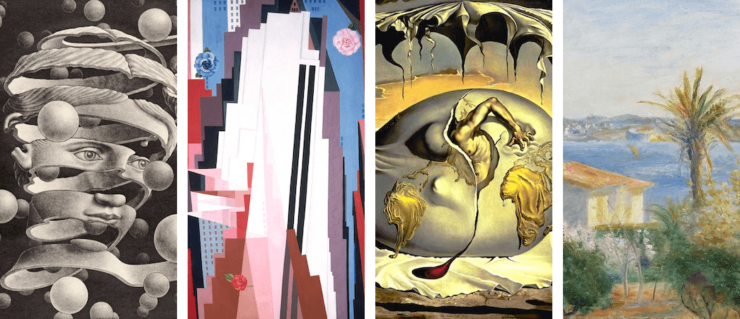Although novels and visual art may seem like vastly different media, both are forms of storytelling—ways of seeing and understanding the world. We paint mental images from words on the page, and we conjure up narratives from brushstrokes on a canvas. Just as one might pair different wines with particular cheeses, so can we match authors with artists, each bringing out the flavors of the other’s work.
Below, I’ve paired eight fantasy and science fiction books with works by famed artists that echo the thoughts and emotions these stories evoked for me…
All the Birds in the Sky by Charlie Jane Anders + Manhattan (1932) by Georgia O’Keeffe
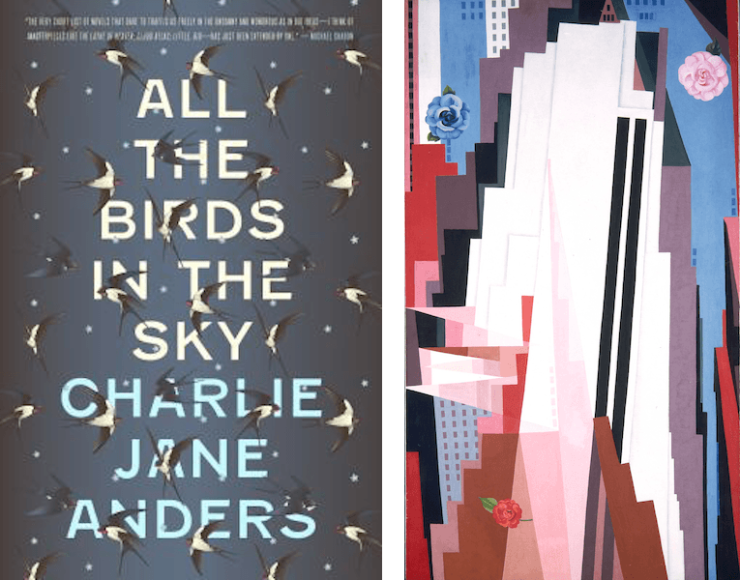
Charlie Jane Anders’s science fantasy novel All the Birds in the Sky explores the friendship between a witch who can communicate with birds and an inventor who builds technological wonders, including a two-second time machine and a supercomputer. Magic and nature are juxtaposed with near-future technology and a world-ending disaster.
Georgia O’Keeffe’s famed painting Manhattan highlights a similar type of contrast. The stark straight lines of a New York skyscraper are overlaid with brightly colored flowers that seem suspended in the air. Here, the urban and the natural collide, almost coalescing in beautiful harmony. The plot of All the Birds in the Sky uses that same synthesis, given that the two protagonists should be utterly incompatible because of the tension between magic and science, yet it’s their coexistence that has the power to stop civilization from unraveling.
Of all O’Keeffe’s paintings, the colors of Manhattan take me back to the prose of All the Birds in the Sky, which is bright, vivid, and charmingly strange.
The Body Scout by Lincoln Michel + Geopoliticus Child Watching the Birth of the New Man (1943) by Salvador Dalí
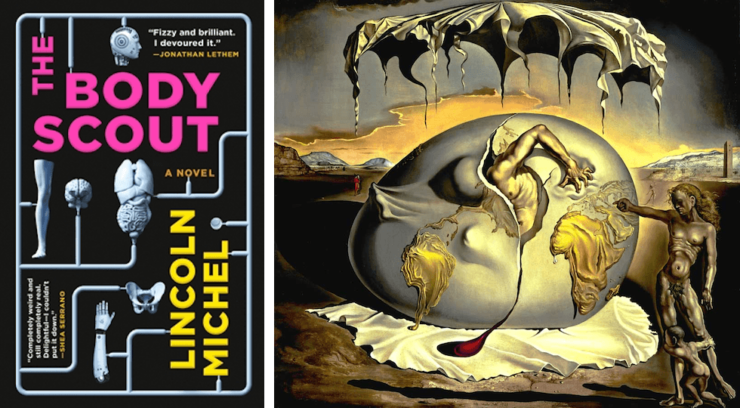
Imagine a future United States where buying body “upgrades” is the norm and the ravages of climate change and capitalism have sunk humanity to a new low. That’s the dystopian setting of Lincoln Michel’s The Body Scout, wherein a former baseball star obsessed with buying the perfect body parts investigates his brother’s murder.
The story’s body horror elements bring to mind the surrealism of Salvador Dalí. In Geopoliticus Child Watching the Birth of the New Man, half of a man’s naked body emerges from an egg-shaped globe, his head and legs stretching the supple skin of Earth. Beside it, an adult figure points, a child cowering around their legs.
Like Dalí, Michel leans into the grotesque, with descriptions of living statues made of flesh and toxic animal hybrids. Both of their creative landscapes exist between a dream and a nightmare, human flesh and forms melting, oozing together. The focus on the man’s arm in the painting is reminiscent of The Body Scout’s protagonist, whose cybernetic arm is a sore point throughout the story.
Some critics believe that Geopoliticus is about the emergence of a new America, as Dalí painted it during his stay in the United States from 1940 to 1948, and that analogy transfers nicely to Michel’s view of a world stretched to its breaking point and a new conception of what it means to be human.
The Ten Thousand Doors of January by Alix E. Harrow + Tamaris, France (1885) by Pierre-Auguste Renoir
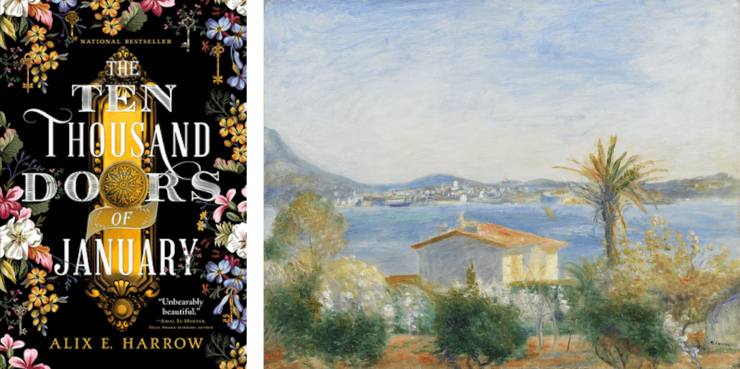
A door standing in the middle of a field can lead a person to strange and captivating lands in Alix E. Harrow’s The Ten Thousand Doors of January. Set in the early twentieth century, this portal fantasy novel tells the story of an adventurous girl searching for her father and escaping an enemy pursuing her across worlds.
I can picture a blue door opening to the scene shown in Pierre-Auguste Renoir’s landscape Tamaris, France. A white-stone building stands among verdant plants and the open sea, buildings nestled at the foot of the distant mountains. The smell of brine floats over the threshold. This is the same shade of world where the novel’s protagonist, January, belongs—the place where she finds happiness, purpose, and family.
Harrow’s novel and Renoir’s paintings share a romantic, expansive quality. Much in the same way the Impressionists focused on light and movement, so does The Ten Thousand Doors of January capture an effervescent feeling in the beauty of its imagery, with January in constant motion in her quest to find the magical doorways and her missing father. And while she faces danger in running from those who would destroy the doorways, the story is ultimately one of love triumphing over fear and bigotry. That exploration of new worlds fills readers with the same wonder and beauty that a Renoir painting impresses on its viewers.
The Fifth Season by N.K. Jemisin + Nature Abhors a Vacuum (1973) by Helen Frankenthaler
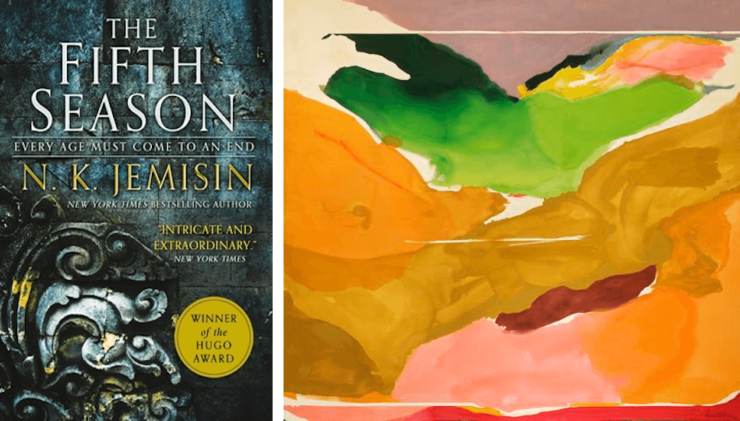
N.K. Jemisin’s The Fifth Season trembles with an undefinable energy. Maybe it’s because of the visceral worldbuilding in this tale of orogenes who can manipulate kinetic energy and create earthquakes powerful enough to rend the planet in two. Or perhaps it’s a product of Jemisin’s unconventional approach to characterization and narrative that intertwines different points of view.
The strata of color in Helen Frankenthaler’s abstract expressionist paintings stir up that same feeling of geology in flux, particularly in Nature Abhors a Vacuum. My eye is first drawn to the bright green splash, then the layers of ocher, orange, and salmon pink beneath it. I won’t pretend to fully understand abstract art, but there is a rawness and spontaneity to Frankenthaler’s approach that reminds me of how Jemisin’s novel flows in both its structure and language.
But more than that, it’s the connection to stone and earth, even in the title Nature Abhors a Vacuum, which is a fitting theme for The Fifth Season, where the power hierarchy demands to be filled, forcing the mighty orogenes to bend to the will of their oppressors. The painting’s dimensions are roughly 8.6 feet by 9.3 feet, a scale that reminds the viewer of their smallness, just as the landscape of The Fifth Season feels massive to the characters trying to traverse it.
Recursion by Blake Crouch + Bond of Union (1956) by M.C. Escher
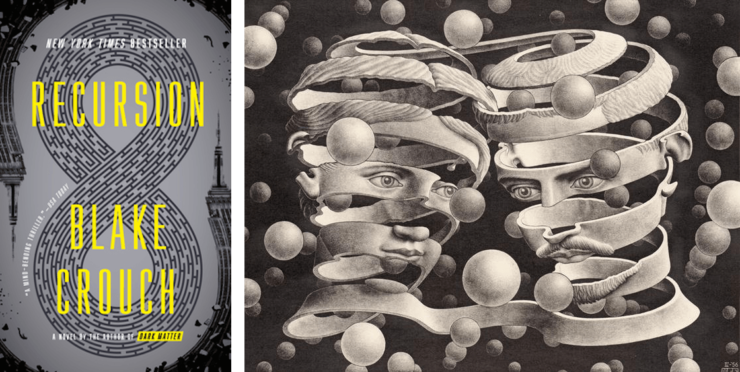
In Recursion by Blake Crouch, random people are plagued by False Memory Syndrome, recalling events that they’re convinced happened but that others don’t remember. The novel alternates between the perspective of a detective investigating the strange occurrences and a neuroscientist researching human memory. Their paths converge as they strive to control a technology with destructive implications.
What better way to represent the continuous nature of time and memory than the mind-bending art of M.C. Escher? Bond of Union reminds me of the dual protagonists’ threaded lives. Like the unbroken ribbons of the two faces in Escher’s lithograph, it’s hard to see where the two characters’ choices begin and end; their lives are inextricably linked. Time is part of that continuous loop, too, as one of the characters explains:
“Time is an illusion, a construct made out of human memory. There’s no such thing as the past, the present, or the future. It’s all happening now.”
The spheres filling the foreground and endlessly fading into the background tie into the idea of recursion. Mathematically, recursion is when a procedure can be applied over and over again, and a solution is derived from that repetition, as long as one avoids creating an infinite loop. In Crouch’s novel, the iteration of memory plays an important role, with a Groundhog Day-esque plot that relies on escaping repeated futures. Escher’s work showcases his obsession with mathematical objects, particularly the idea of infinity. His symbolic art and Recursion’s explorations of memory technology challenge our perceptions of how reality is structured.
Kindred by Octavia E. Butler + Lift Every Voice and Sing (1939) by Augusta Savage
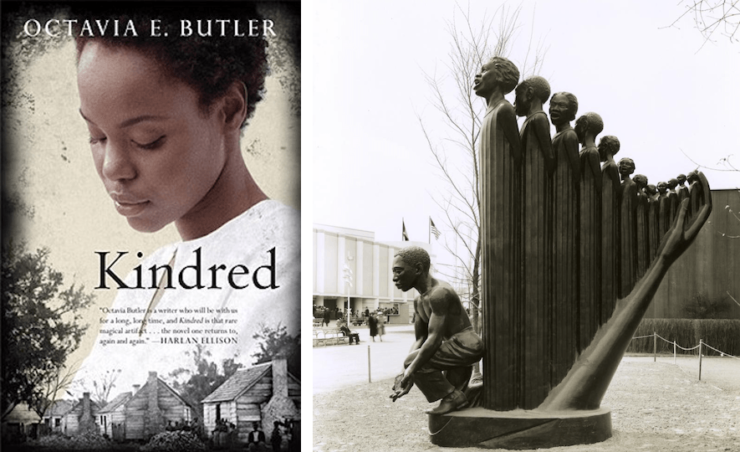
Author Octavia E. Butler and sculpture artist Augusta Savage both emphasize the idea of cultural lineage in their art. Butler’s novel Kindred focuses on ancestry, with a Black woman from 1970s Los Angeles traveling back in time to antebellum Maryland where she meets her ancestors—both the enslaved and the slavers. Butler wrote Kindred to drive home the severity and brutality of slavery in a way that factual accounts alone can’t achieve. She wanted the physical and emotional pain to be felt down to the bone, not viewed from the faraway vantage point of history books.
Lift Every Voice and Sing creates that same type of emotional closeness to Black history and identity. The 16-foot sculpture portrays twelve young Black singers in choir robes standing as the strings of a harp, a giant hand forming the sounding board. The 1939 New York World’s Fair commissioned Augusta Savage to create this sculpture; she was the only Black woman to be selected. She originally named the piece after the famous poem by James Weldon Johnson, which was set to music by his brother J. Rosamond Johnson and became known as the Black National Anthem. However, the event organizers renamed the sculpture “The Harp,” perhaps because that was a less “controversial” choice.
Just as Augusta Savage pushed for recognition of her art, so did Octavia E. Butler pave her own path as a Black female writer in the science fiction community, becoming one of the preeminent voices in a largely white- and male-dominated space. When I came across a picture of the sculpture, I was reminded of the first-edition cover of Kindred from 1979, which depicts two Black women back-to-back, an hourglass blurred between them. Augusta Savage’s symbolism and the melding of past and present in Octavia Butler’s novel echo the lyrics of “Lift Every Voice and Sing”:
“Out from the gloomy past,
’Til now we stand at last
Where the white gleam of our bright star is cast.”
The two artists are kindred spirits speaking to their own legacy of pain, strength, resilience, and hope.
A Memory Called Empire by Arkady Martine + Composition with Figures (1914) by Lyubov Popova
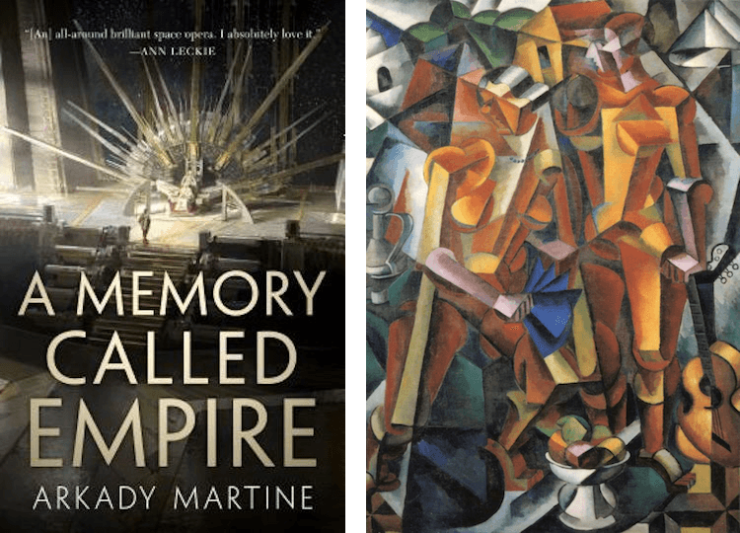
Works that deconstruct familiar ideas have always fascinated me. That’s why I felt drawn to both Arkady Martine’s science fiction novel A Memory Called Empire—which reinterprets the concept of space empires—and Lyubov Popova’s Composition with Figures, a Cubo-Futurist rendering of two women and classic still-life motifs.
Martine complicates the usual power dynamics found in space operas. Typically, one might read about a colonizer encountering “alien” life, or about an oppressed group rebelling against tyrannical outsiders. But in this novel, the outsider protagonist grapples with the fact that she can never fully assimilate into the empire and simultaneously fears for her own culture’s erasure.
There’s a sense of fractured identity in A Memory Called Empire that’s paralleled in Composition with Figures, where the focal point is two women, much as two female characters are the focal point in Martine’s novel. The hallmarks of Cubo-Futurism—an early twentieth-century Russian art movement—include a focus on movement, geometric shapes, dynamic colors, industrial life, and deconstruction. People and everyday objects are broken apart and put back together into new, abstract formations. Similar to how Martine reimagines the familiar sci-fi concept of colonization, Popova subverts her own set of “genre tropes” with her fragmented versions of a bowl of fruit, a guitar, and playing cards, all of which are typical subjects in a still-life painting.
Both artists render recognizable elements through new perspectives, colors, and contrasts, with Martine dedicating her book to “anyone who has ever fallen in love with a culture that was devouring their own” and Popova using future-focused deconstructions of other art movements to create a unique way of seeing.
The Library at Mount Char by Scott Hawkins + Golconda (1953) by René Magritte
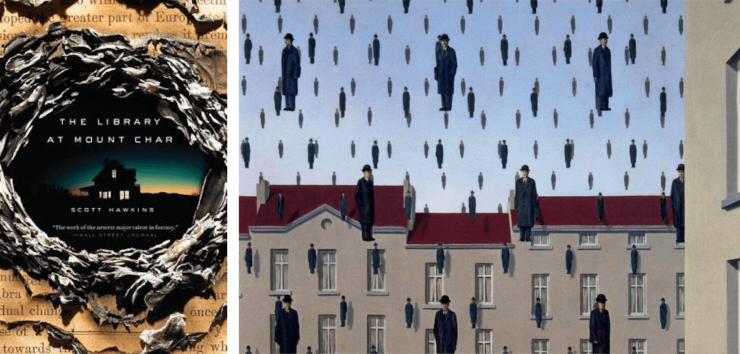
It’s a no-brainer to pair Scott Hawkins’s fantasy/horror head-trip The Library at Mount Char with the work of Belgian surrealist René Magritte. Both are supernatural, dark, and weird, but still somehow don’t take themselves too seriously.
In Magritte’s painting Golconda, it’s raining men. More than a hundred male figures in long black coats and bowler hats dot a blue sky above a nondescript rooftop. The men aren’t flailing as they fall, however; they’re standing as if on invisible platforms, their body language as casual as can be. Some of the faces stare directly at the viewer like they’re breaking the fourth wall, as if observing the strangeness that is you while you observe the strangeness that is them.
Like Magritte, Hawkins takes elements grounded in reality and makes them feel out of place, even eerie. The premise of The Library at Mount Char is fairly straightforward: after being kidnapped by a godlike man, a group of children become “librarians” specializing in different kinds of esoteric knowledge. That pithy summary doesn’t do the story justice, as the novel revels in its own chaos: The writing feels like a fever dream, flinging the reader between dark and violent scenes to hilarious dialogue between quirky characters.
Hawkins’s novel is often classified as urban fantasy because of its contemporary setting, but really I think it shares the label of “surrealism” that defines Magritte’s paintings. Both works feature illogical scenes that seem like expressions of the unconscious. They are ambiguous and unfathomable, beyond our understanding—yet neither work needs to be fully understood in order to be fully felt.
***
What books and paintings would you pair together? I’d love to hear your match-ups and alternate suggestions in the comments!
Diane Callahan spends her days shaping stories as a writer and developmental editor. Her YouTube channel, Quotidian Writer, provides practical tips for aspiring authors.










